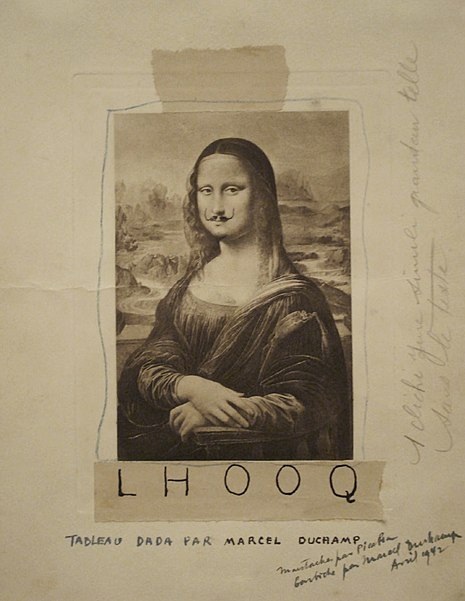up Isabella d’Este’s portrait, complaining of Leonardo’s ‘haphazard andextremely unpredictable’ routine. This frustrating restlessness was, ofcourse, integral to the obsessive creativity. Pacioli had been able to draw aline under a piece of work and consider it done, but for Leonardo thisrepresented a mental hurdle that he frequently failed to clear. He leftpaintings unfinished for decades – Lisa del Giocondo sat for the Mona Lisawhen she was in her early twenties, and was thirty-nine when Leonardodied, still working on it – and he evidently felt similarly about hismanuscripts and notebooks
- Jul 2025
-
Local file Local file
-
- Apr 2022
-
en.wikipedia.org en.wikipedia.org
-
https://en.wikipedia.org/wiki/L.H.O.O.Q.
L.H.O.O.Q. is a Marcel Duchamp readymade artwork conceived in 1919. The work consists of a cheap postcard reproduction of Da Vinci's Mona Lisa (the found object or objet trouvé), "improved" by Duchamp with the addition of a penciled in moustache and a goatee with the title drawn in large capital letters underneath.

L.H.O.O.Q. is a pun whose letters pronounced one at a time in French sound like "Elle a chaud au cul". This translates variously as "She is hot in the arse" or "She has a hot ass". "Avoir chaud au cul" is a vulgar expression implying that a woman has sexual restlessness. Duchamp, in an interview, gave a loose translation of L.H.O.O.Q. as "there is fire down below". (Schwarz 203)
Was the the original artistic source for the long string of childhood pranks in which children were often seen marking up and defacing pictures in books and magazines? Were there others prior?
-
The creation of L.H.O.O.Q. profoundly transformed the perception of La Joconde (what the French call the painting, in contrast with the Americans and Germans, who call it the Mona Lisa).
While Americans and Germans call Leonardo da Vinci's painting the Mona Lisa, the French refer to it as La Joconde.
What do the French call the Mona Lisa? :: La Joconde
-